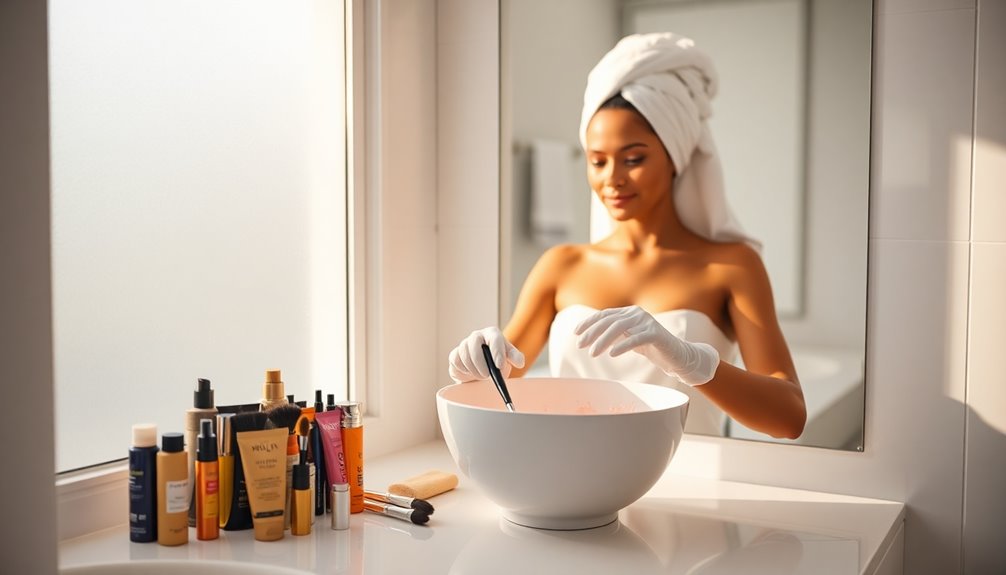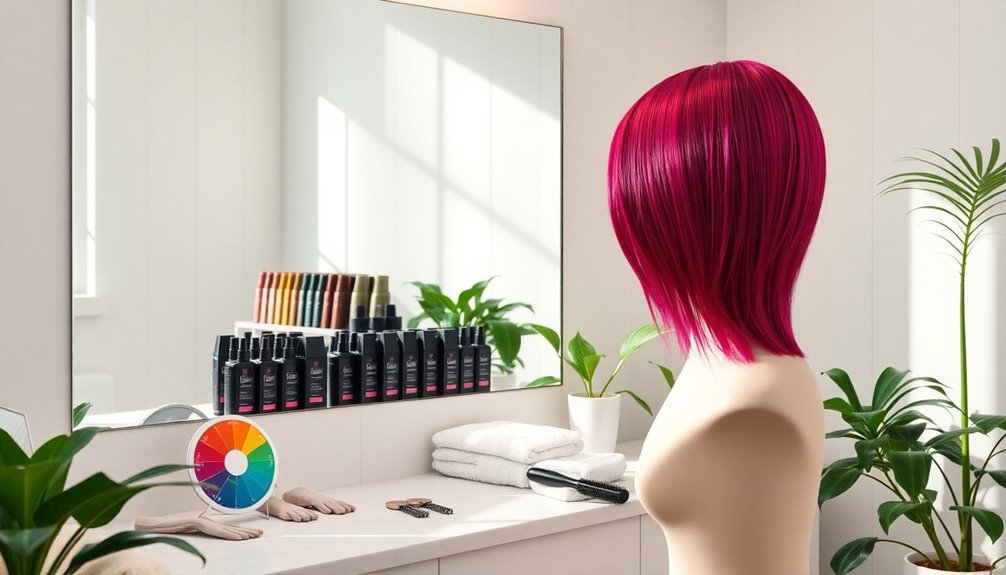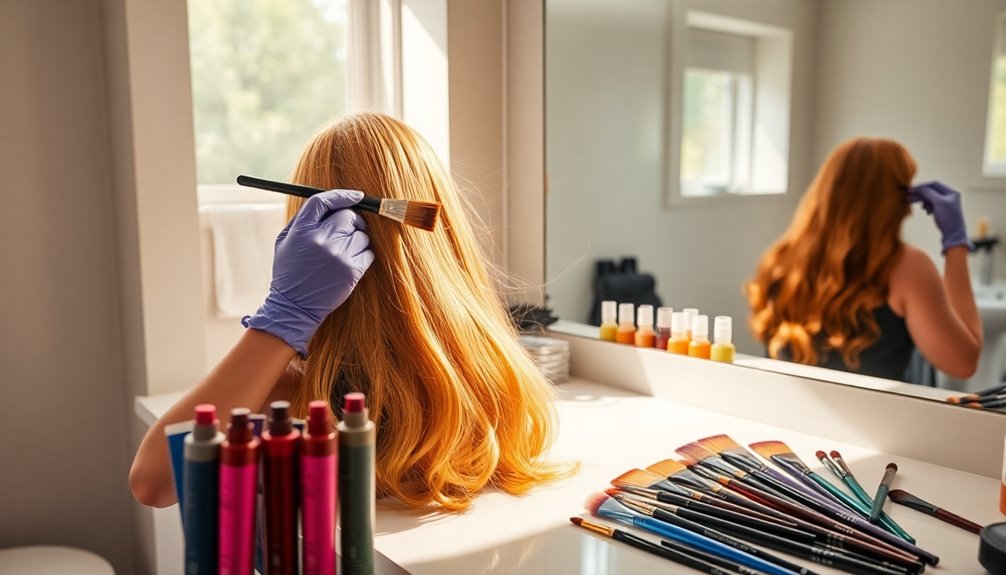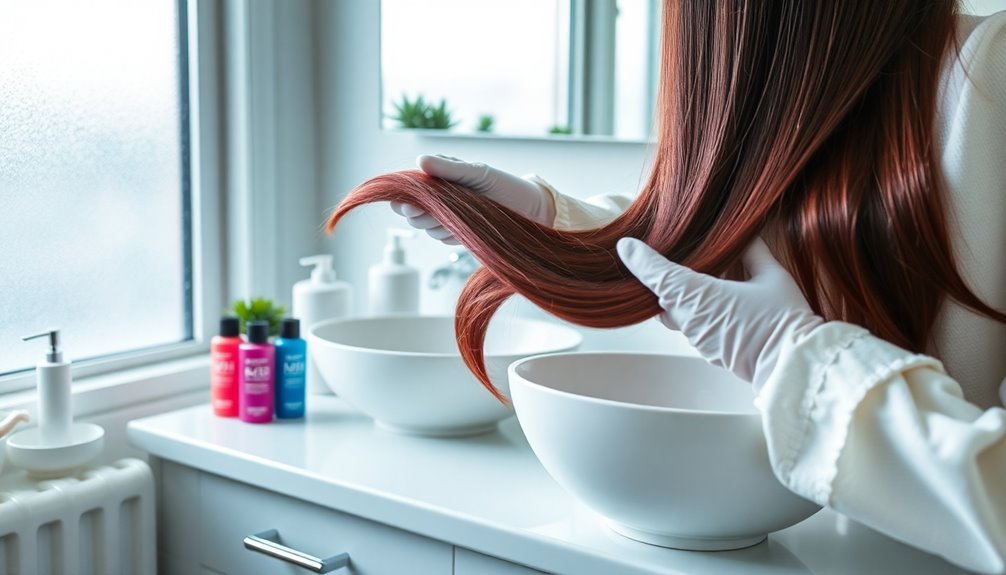To dye your hair at home like a pro, start with safety by waiting two weeks after any chemical treatments and doing a patch test. Choose a hair color that suits your skin tone, and section your hair for easy application. Apply the dye carefully, starting from the back and avoiding your scalp initially. Monitor the processing time and follow up with a color-safe conditioner. Stick around to discover more expert tips and techniques for stunning results.
Key Takeaways
- Conduct a patch test and strand test 48 hours before dyeing to prevent allergic reactions and ensure hair can handle the dye.
- Choose the right hair color by considering your current shade and skin tone, and stay within two levels for a natural look.
- Section hair into at least four parts and apply dye precisely, starting from the back and avoiding roots initially to prevent over-saturation.
- Monitor processing time closely, checking color progress every 5 to 10 minutes to avoid over-dyeing and achieve desired results.
- Maintain your color with sulfate-free shampoos, limit washes, and use deep conditioners weekly to nourish and protect your hair.
Is It Safe to Use Hair Dye?

Is it really safe to dye your hair at home? Generally, yes, it's safe to use hair dye, especially box dye, as long as you take necessary precautions.
First, if you've had any chemical treatments, wait at least two weeks before dyeing. Always perform a patch test 48 hours prior to application to check for allergic reactions. Additionally, using essential oils for scalp health can help create a healthier environment for your hair.
If you've had chemical treatments, wait two weeks before dyeing and always conduct a patch test 48 hours prior.
Reading the instructions thoroughly guarantees you use the dye correctly and safely. However, if your hair is damaged from multiple chemical processes, it's best to avoid box dye, as it could worsen your hair's health.
To protect your scalp, maintain a natural oil barrier by not washing your hair for two days before dyeing. Your hair deserves the best care! Additionally, it's important to be aware of common symptoms of hair damage, such as excessive breakage or dryness, which can indicate that your hair may not tolerate dyeing well.
How to Choose a Hair Colour Which Suits You

Choosing a hair color that suits you can feel overwhelming, but focusing on a few key factors can simplify the process.
Start by identifying your current hair shade using color-level numbers; aim to stay within two levels for a natural change. Regular skin treatments can also help ensure your hair remains healthy and vibrant as you change your color.
Next, consider your skin tone. If you have a warm skin tone, go for golden or honey shades, while cool tones look great with ash or beige hues.
Use a color wheel to find complementary colors based on your undertones; rich chestnut or warm caramel can enhance your look.
Finally, test a few shades with temporary hair dyes or color swatches to see how they complement your overall appearance in different lighting before making your final choice. Additionally, consider using purple shampoos to help maintain your color and neutralize any unwanted brassy tones after dyeing.
How to Dye Your Hair All Over

When you're ready to dye your hair all over, start by choosing the right shade that fits your style and hair type.
Preparing your hair is essential for ideal color absorption, so make sure you wash it properly before application.
Once you're set, you can focus on effective application techniques to achieve a beautiful, even color. Additionally, ensure your skin is well cared for by using products with ingredients like glycolic acid, which can help improve overall skin texture and tone.
Choose the Right Shade
How can you guarantee your new hair color complements your natural look? Start by choosing the right shade within two levels of your current color using the colour-level numbering system.
Consider your complexion; avoid drastic changes that might wash you out. Permanent hair dyes work best for all-over color, ensuring a consistent result. Additionally, essential oils can be used as natural alternatives to help maintain healthy hair and scalp during the dyeing process.
Don't forget to conduct a patch test 48 hours before dyeing to check for allergic reactions and confirm the shade suits your hair type. Additionally, make sure to check for changes in the dye's consistency over time to ensure optimal results.
If you're unsure about the perfect match, consult a professional or try virtual hair color tools available on beauty retailer websites.
This way, you'll feel confident that your new look enhances your natural beauty!
Prepare Your Hair
Before you start the dyeing process, it's important to prepare your hair properly to guarantee the best results.
Begin by washing your hair with a clarifying shampoo 24 hours before you dye your hair. This removes buildup but avoid deep conditioning afterward, as it can leave residues that affect color absorption. Using a sulfate-free option can help maintain color vibrancy during this preparation phase.
In the two days leading up to dyeing, avoid washing your hair to let natural oils form a protective barrier, minimizing scalp irritation.
Also, make sure your hair is free of any styling products like hairspray or mousse, which can hinder dye penetration.
Finally, don't forget to conduct a patch test 48 hours prior to make sure there are no allergic reactions to the dye you choose. Additionally, be aware that some hair dyes may contain potential allergens that could cause reactions similar to those seen in certain individuals with sensitivities.
Application Techniques Explained
To achieve an even and vibrant color, start by sectioning your hair into at least four equal parts.
Use clips to keep these sections manageable, which helps guarantee even application.
When you're ready to apply the dye, begin about half an inch away from your scalp to avoid over-saturation.
Apply the dye throughout the lengths of your hair, covering the roots halfway through the processing time for ideal results.
A color brush is your best friend here; it allows for precise application, assuring each strand is fully saturated.
Always follow the manufacturer's instructions for processing time and set a timer to prevent any mishaps.
Once you're done, rinse and use the included conditioner to seal in color and maintain vibrancy.
Additionally, maintaining color accuracy in your hair dye application can enhance the overall visual appeal of your new shade.
How to Highlight Your Hair

When you're ready to highlight your hair, start by choosing a highlighting kit that's one shade lighter than your base color for a natural look.
Next, section your hair into small pieces to guarantee even application and use a brush for precision.
With the right techniques, you'll achieve beautiful highlights that brighten your overall style.
Choosing Highlighting Kits
Choosing the right highlighting kit can make all the difference in achieving beautiful, natural-looking highlights. Opt for a kit that's one shade lighter than your base color for the best results. Look for kits with a precise applicator for accurate application and better control. To guarantee even distribution, section your hair into manageable pieces—10 quarter-inch-wide sections work well.
| Feature | Importance | Tips |
|---|---|---|
| Shade Selection | Natural-looking highlights | Choose one shade lighter than base |
| Applicator Quality | Accurate application | Use a toothbrush or brush |
| Processing Time | Prevent over-processing | Check a strand early |
Finish with a clear gloss treatment to seal the color and boost shine!
Application Techniques Explained
Once you've selected the perfect highlighting kit, it's time to focus on application techniques that will help you achieve stunning results.
For a foolproof guide to DIY hair highlighting, follow these tips:
- Section your hair into 10 quarter-inch-wide pieces for even application.
- Use a toothbrush to apply the dye starting from the front sections, and prop highlighted pieces with cotton balls to prevent dye bleeding.
- Regularly assess the color during processing to avoid over-dyeing, which can lead to brassiness.
Choose a shade that's one tone lighter than your base color for a natural look, especially on color-treated hair.
Finish with a clear gloss treatment to seal in the color and enhance shine, just like professional hair results!
How to Dye Your Hair Blond (Or Blonder)

Dyeing your hair blonde at home can be a rewarding experience if you follow some key steps to achieve the best results while minimizing damage.
The first step is to perform a strand test to verify your hair can handle the dye.
When you're ready, apply the blonde dye starting at the back of your head, keeping it at least one inch away from your roots. This prevents over-processing at the scalp.
Check the color's progress every 5 to 10 minutes during the 20 to 30-minute processing time.
Once you reach your desired shade, apply the dye to your roots for an additional 10 to 30 minutes.
What to Do if You Hate Your New Hair Color

If you find yourself unhappy with your new hair color, don't panic—there are several steps you can take to improve the situation.
Start by washing your hair with a clarifying shampoo to strip away some of the dye. Here are a few options to evaluate:
- For dark hair, follow up with a deep conditioner to restore moisture.
- If your color is too light or brassy, use a lavender-hued shampoo to neutralize unwanted tones.
- If at-home fixes don't work, consult a professional colorist for color correction.
Having pantry items like olive oil or ketchup can also help if you need to neutralize green tones or add moisture.
How to Make Your Hair Color Last

Feeling dissatisfied with your hair color can be frustrating, but once you've recovered from any mishaps, you'll want to focus on maintaining that vibrant hue.
To make your hair color last, start by using sulfate-free and color-safe shampoos and conditioners. Limit washing your hair to just two or three times a week, as frequent washing strips away color and moisture.
For vibrant hair color, opt for sulfate-free products and wash your hair only two to three times a week.
Incorporate a weekly deep conditioner to nourish and hydrate your color-treated hair, keeping it healthy and strong. Don't forget to use UV protectant sprays before sun exposure to prevent fading.
Additionally, regular glossing treatments can boost shine and refresh your color, with results lasting up to 10 days.
With these tips, you'll keep your color looking fresh and radiant!
Top Tips for Dyeing Your Hair at Home

When you're ready to change your hair color at home, having a game plan is fundamental for achieving the best results. Here are some top tips to guarantee your hair transformation is a success:
- Patch Test: Always conduct a patch test 48 hours before dyeing to check for allergic reactions.
- Prep Your Hair: Wash your hair with clarifying shampoo the day before, avoiding deep conditioner to prevent product build-up.
- Section Wisely: Divide your hair into manageable sections, starting with the roots and working your way to the back sections for even application.
Set a timer according to the dye's instructions, and remember not to over-process your hair.
Rinse thoroughly and use the included conditioner to seal in color and maintain vibrancy. Enjoy your new look!
How to Look After and Protect Dyed Hair

To keep your dyed hair looking vibrant and healthy, it's essential to adopt a dedicated care routine.
Start by using sulfate-free and color-preserving shampoos and conditioners to maintain vibrancy and prevent fade. Limit washing to 2-3 times a week, using dry shampoo on non-wash days to lock in moisture.
Use sulfate-free, color-preserving shampoos and conditioners, wash 2-3 times a week, and apply dry shampoo on off days.
Incorporate weekly deep conditioning treatments to restore hydration and strengthen hair bonds, especially if your hair feels damaged from dyeing.
Before heading out in the sun, apply a UV protectant spray to shield your color from fading due to harmful rays.
Finally, use color-enhancing glosses regularly for an extra boost of shine and to refresh your color, ensuring the results last up to 10 days between treatments.
Frequently Asked Questions
How to Dye Your Hair Professionally at Home?
To dye your hair professionally at home, start by choosing a high-quality hair color kit and preparing your workspace.
Section your hair into four parts for even application. Apply dye to your roots first, then work it through the lengths.
Set a timer to avoid over-processing, and rinse thoroughly until the water runs clear.
Afterward, use the included conditioner and maintain your color with sulfate-free products to keep your hair vibrant and healthy.
How to Get the Best Results With at Home Hair Dye?
Imagine you're prepping for a big event and want your hair to shine.
To get the best results with at-home hair dye, always do a patch test first to avoid surprises. Pick a shade close to your current color for a natural look.
Wash your hair with clarifying shampoo a day before, and section it during application.
Follow the instructions closely, especially the processing time, to prevent damage and achieve vibrant results.
Is It Better to Dye Hair When It's Wet or Dry?
It's generally better to dye your hair when it's dry.
Dry hair allows the dye to absorb more effectively and provides a more even application. When your hair's wet, the dye can dilute, leading to less vibrant results and uneven color.
However, if you're looking for softer highlights, wet hair might work better.
Always check the manufacturer's instructions, as some products are specifically designed for either wet or dry application.
What Should You Not Do Before Dying Your Hair?
Before you plunge into dyeing your hair, think about this: would you paint a masterpiece on a dirty canvas?
You wouldn't want to wash your hair for at least two days, allowing natural oils to protect your scalp. Skip heavy styling products and deep conditioners to guarantee the dye absorbs well.
Also, don't dye your hair right after chemical treatments or jump into drastic color changes; it can do more harm than good.
Conclusion
Dyeing your hair at home can feel like an intimidating task, but with the right tips and techniques, you'll be a pro in no time! Embrace your new look and remember that even if things don't go as planned, you can always adjust. By following our advice, you'll keep your color vibrant and your hair healthy, making you feel like a million bucks. So grab that dye, release your creativity, and transform your hair into a masterpiece!









